A new situation has come about within the Christian community itself. . .with regard to the Church’s moral teachings. It is no longer a matter of limited and occasional dissent, but of an overall and systematic calling into question of traditional moral doctrine.
So stated Pope John Paul II in his latest encyclical, Veritatis splendor. The situation is indeed very new. Church historians may not agree as to how far back in time they should go to find a situation similar to the one described in the encyclical. But they would certainly agree that no encyclical issued during the last 200 years contains a statement even remotely as ominous.
Not that during those two very modern centuries there has been no dissent. Also, the dissent could be so radical as to call for the harshest conceivable words of condemnation. Thus in his encyclical, Pascendi dominici gregis, Pius X decried, in 1907, the modernist position as a “delirium,” an “insanity,” an “audacious sacrilege,” a “monstrosity.” He used such extremely harsh words only because he felt he could thereby alert each and all to the seriousness of an error which, however, was held only by a few, indeed only by a very few.
Moreover, that saintly pope did not have to face a dissent in moral theology, which, concretely or existentially speaking, is always far more serious than a dissent in matters of faith. Dissent in morals involves not merely man’s head but also his very flesh and blood that pull him away from truth with a far greater force than would purely intellectual urges. The following of Christ has indeed its moment of truth when one has to deny oneself and take up the cross not only once or twice but, as we have it in St. Luke’s Gospel, each and every day.















